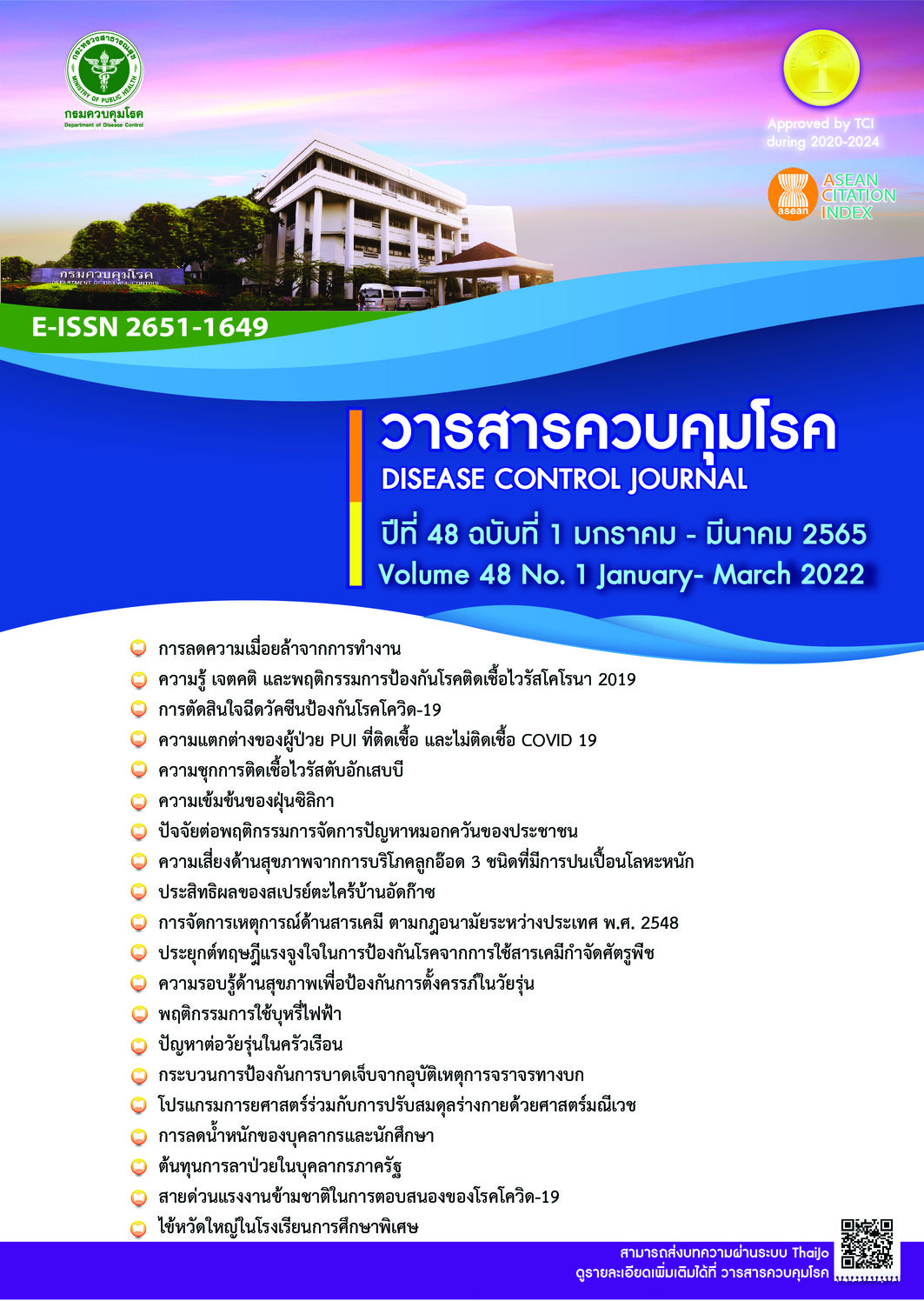The influence of factors on behavior toward smog problem management of people in community: A case study of Ban Hong Luang, Lamphun province
DOI:
https://doi.org/10.14456/dcj.2022.7Keywords:
knowledge, attitude, perception, smog problem managementAbstract
This study aims to examine the behavior on smog problem management and investigate the factors influencing behavior on smog problem management of people in Ban Hong Luang community, Ban Hong District, Lamphun Province. We recruited 392 people in Ban Hong Luang community through the systematic random sampling. Data were collected by using questionnaire and analyzed by using Chi-square test statistics and rank logistic regression. This study found that gender, knowledge, attitude, awareness and participation of people in the community associated with behavior on smog management (p-value<0.05) and could explain the behavior on smog management at 79.6%. Promoting the participation of people by enhancing knowledge, understanding and public awareness regarding the impact of air pollution from smog could encourage smog management behavior.
Downloads
References
Vinitketkumnuen U, Kalayanamitra K, Chewonarin T, Kamens R. Particulate matter, PM 10 & PM 2.5 levels, and airborne mutagenicity in Chiang Mai, Thailand. Mutat Res. 2002; 519(1-2):121-31.
Pothirat C, Chaiwong W, Liwsrisakun C, Bumroongkit C, Deesomchok A, Theerakittikul T, et al. Influence of Particulate Matter during Seasonal Smog on Quality of Life and Lung Function in Patients with Chronic Obstructive Pulmonary Disease. Int J Environ Res Public Health. 2019;16 (1):106.
Department of Health, Department of Disease Control. Guidelines for surveillance of areas at risk of air pollution Case of Haze. Nonthaburi: Department of Health, Department of Disease Control; 2015.
Sivakumar M, Hansen J. Climate prediction and agriculture: Advances and challenge. Springer Berlin Heidelberg; 2010. 306 p.
Wiwatanadate P. Lung Cancer Related to Environmental and Occupational Hazards and Epidemiology in Chiang Mai, Thailand. Environ Mutagen. 2011;33(4):120–7.
Pollution Control Department. Air quality and noise [Internet]. 2006 [cited 2013 Apr 28]. Available from: http://www.pcd.go.th/info_serv/air_aqi.htm.
Trakarnsririnon P, Keawkingkeo S, Asawimalkit U, Pungkiew C, Wiwattanadate P, Ladavalya Na Ayuthya S. The Project of Strengthen the Community in Solving the Haze Crisis Activities to Research alternatives to haze problems and the development of surveillance networks in the basin area in Chiang Mai. Chiang Mai University, Faculty of Political Science and Public Administration; 2011.
The Office of Disease Prevention and Control 1st, Chiang Mai. Report on the Situation and Actions to Solve the Smoke Problem on the Public Health in the 8 Provinces of the Upper North Thailand in 2017. Chiang Mai: Epidemiology and Intelligence Group, the Office of Disease Prevention And Control 1st, Chiang Mai; 2017.
Ban Hong Hospital. Report of patient information in 4 disease groups by disease code (ICD10) Ban Hong Hospital, January - April 2015-2017. Lamphun: Ban Hong Hospital; 2017.
Krejcie RV, Morgan DW. Determining Sample Size for Research Activities. Educational and Psychological Measurement. 1970;30(3):607-10.
Plan Ban Hong Subdistrict Municipality. Four-Year Local Development Plan of Ban Hong Subdistrict Municipality, Ban Hong District, Lamphun Province, 2013-2016. Ban Hong, Lamphun: Plan Ban Hong Subdistrict Municipality; 2012.
Kongurai U, Hemmara C, Pancharat P, Wankhamlue K, Ruengchan Y. Perception of Smog Pullution Problems and Self-care to Mitigate the Hazardous Haze that Affect the Health of People in Northern Provinces. Academic Journal Institute of Physical Education. 2017;9:1-15.
Unthongdee N. Public Participation in Prevention and Solution of Haze Air Pollution in Mae Hong Son Province. Bangkok: National Institute of Development Administration University; 2013.
Pongtherdsak N, Koychusakun P, Chuenwong P. Knowledge and Behaviors on their Smog Protection in Chanchawa Municipality, Mea Chan District, Chiangrai Province. Chiang Rai University Graduated School Journal. 2015;8(17):140-7.
Charus P. Public Attitudes in Solving Haze Problems in Mae Ka Subdistrict Municipality, Mueang District, Phayao. Phayao: Phayao University; 2013.
Kasempitakpong A. Behavior and Awareness Sustainable Smog Management in Lamphun Municipality Area. Chiang Mai: Chiang Mai University; 2010.
Thai Health Promotion Foundation. The collaborative project for forest fire management to reduce haze problem: Foundation for Sustainable Development. Chiang Mai: Co-khayan Media Team; 2013.
Downloads
Published
How to Cite
Issue
Section
License
Copyright (c) 2022 Disease Control Journal

This work is licensed under a Creative Commons Attribution-NonCommercial-NoDerivatives 4.0 International License.
Articles published in the Disease Control Journal are considered as academic work, research or analysis of the personal opinion of the authors, not the opinion of the Thailand Department of Disease Control or editorial team. The authors must be responsible for their articles.






